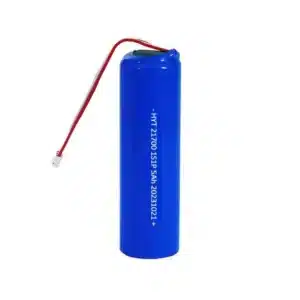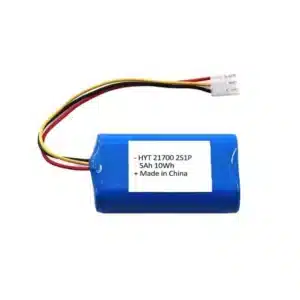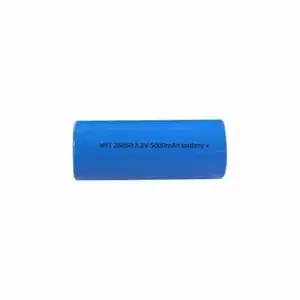Golf Cart Batteries
Lithium golf cart batteries are becoming increasingly popular as an alternative to traditional lead-acid batteries (agm golf cart batteries )for powering electric golf carts. They offer several advantages over lead-acid batteries:
Lightweight: Lithium batteries weigh about one-third of equivalent lead-acid batteries.
Long-lasting: They offer significantly longer endurance than lead-acid batteries.
Maintenance-free: Unlike lead-acid batteries that require regular watering, lithium batteries are maintenance-free.
We mainly produce 12 volt golf cart batteries, 36 volt golf cart batteries, and 48 volt golf cart batteries.

High energy density
LiFePO4 batteries can store more energy in a smaller, lighter volume.
Long lifespan
They last 2-3 times longer than lead-acid batteries, reaching 3,000-6,000 cycles.
Fast charging
Can reach 80% capacity within one hour.
Stable output power
The discharge curve is smooth with good consistency.
golf cart lithium batteries product
Based on the size of the customer’s golf cart battery compartment, power requirements, and current parameters, we recommend different LiFePO4 batteries. All our cells are from major domestic LiFePO4 brands, ensuring quality and reasonable prices.
Below are some of the 12v, 36v, and 48v golf cart batteries we produce. Except the shown models, as a China golf cart battery factory, we can produce what you want.
- Lithium Golf Cart Batteries
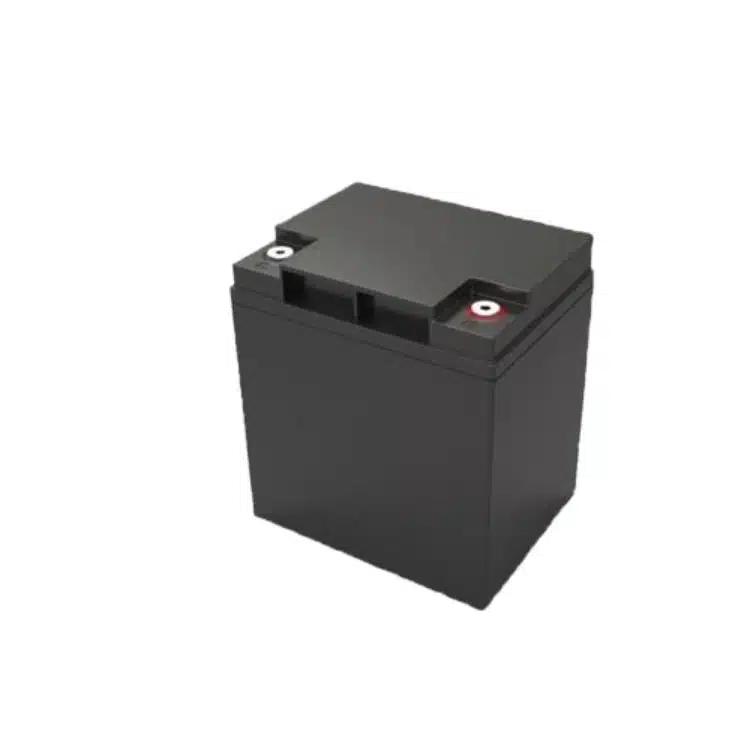
12.8V 30Ah LiFePo4 Battery
Nominal voltage: 12.8V
Nominal capacity: 30Ah
Rated energy: 384Wh
Recommend charge current: ≤15A
Peak discharge current: 60A
Internal resistance: ≤30mΩ
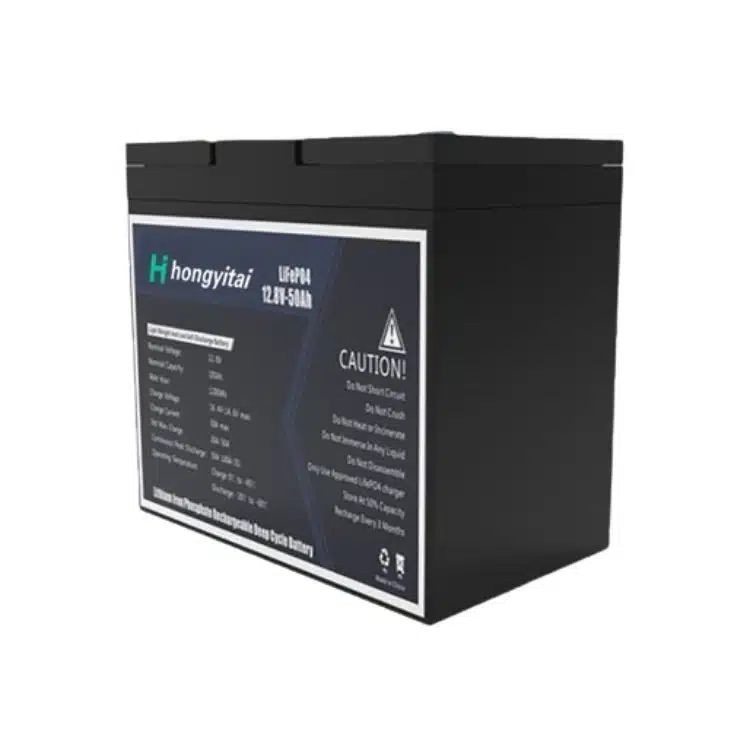
12.8V 50Ah LiFePo4 Battery
Nominal voltage: 12.8V
Nominal capacity: 50Ah
Rated energy: 640Wh
Recommend charge current: ≤25A
Max charge current: 100A
Internal resistance: ≤15mΩ
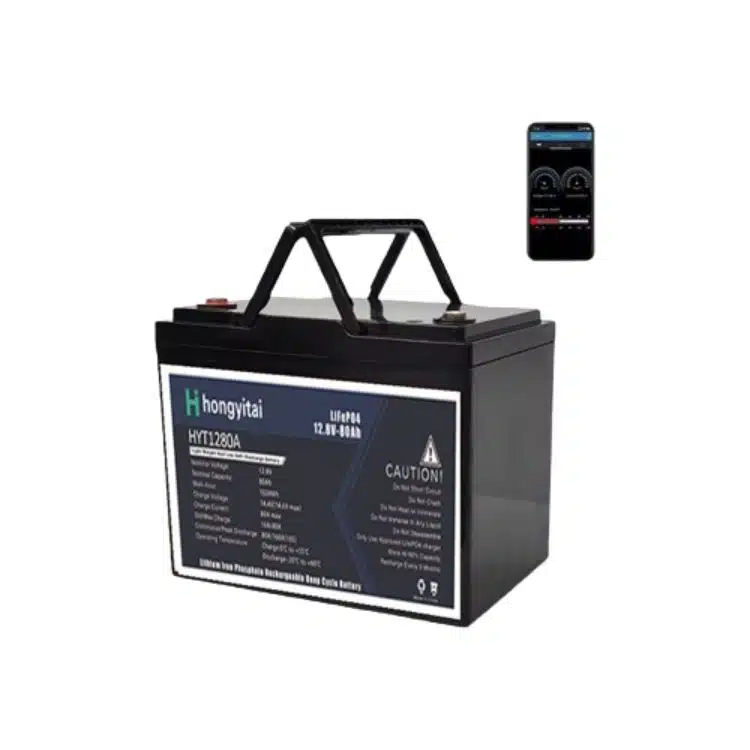
12.8V 80Ah LiFePo4 Battery
Nominal voltage: 12.8V
Nominal capacity: 80Ah
Rated energy: 1024Wh
Recommend charge current: ≤40A
Max charge current: 160A
Internal resistance: ≤12mΩ
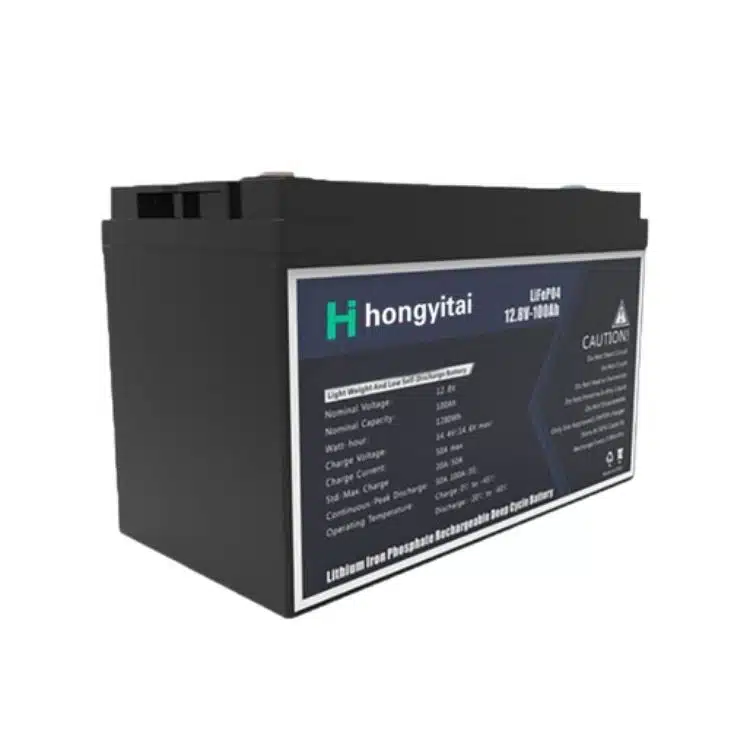
12.8V 100Ah LiFePo4 Battery
Nominal voltage: 12.8V
Nominal capacity: 100Ah
Rated energy: 1280Wh
Recommend charge current: ≤50A
Max charge current: 200A
Internal resistance: ≤10mΩ
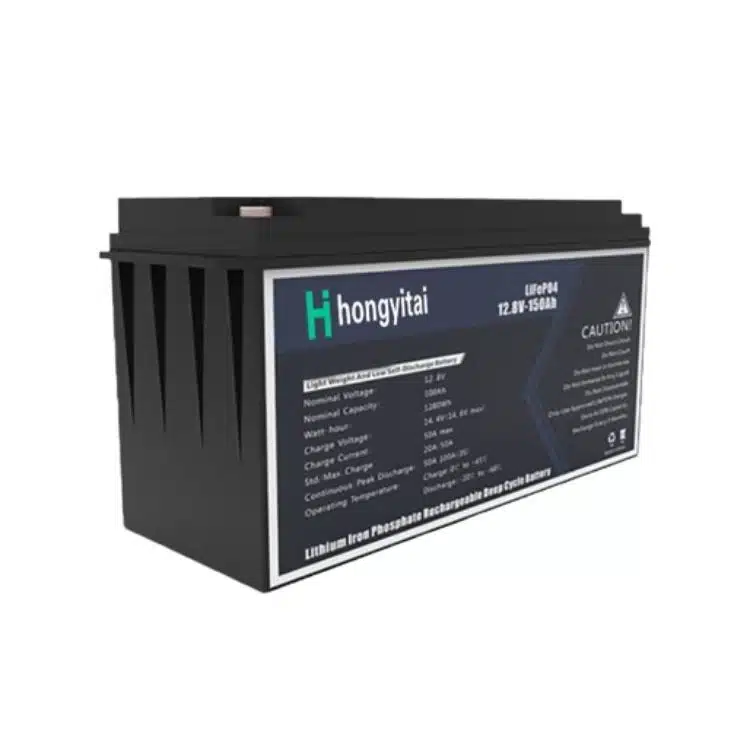
12.8V 150Ah LiFePo4 Battery
Nominal voltage: 12.8V
Nominal capacity: 150Ah
Rated energy: 1920Wh
Recommend charge current: ≤100A
Max charge current: 300A
Internal resistance: ≤10mΩ
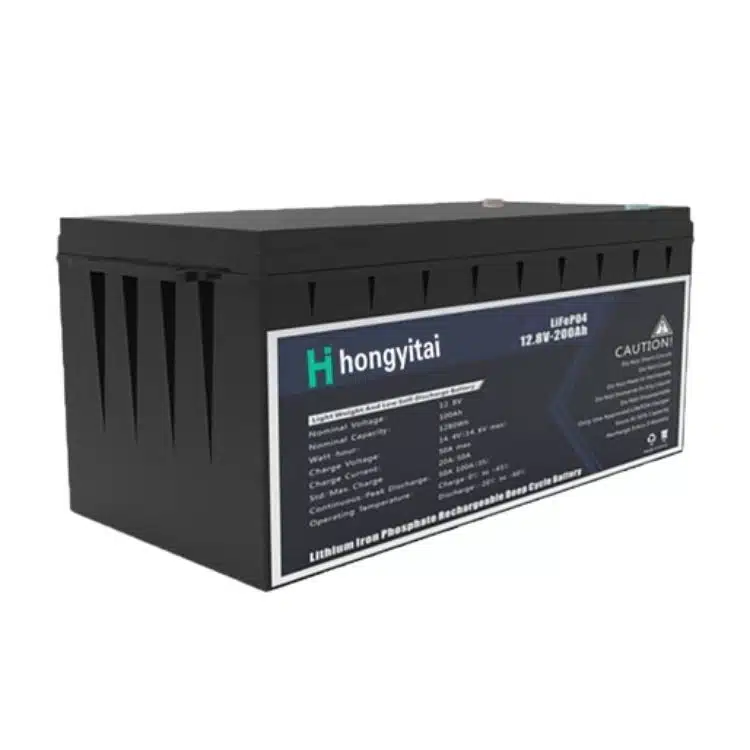
12.8V 200Ah LiFePo4 Battery
Nominal voltage: 12.8V
Nominal capacity: 200Ah
Rated energy: 2560Wh
Recommend charge current: ≤100A
Max charge current: 200A
Internal resistance: ≤10mΩ

12.8V 300Ah LiFePo4 Battery
Nominal voltage: 12.8V
Nominal capacity: 300Ah
Rated energy: 3840Wh
Recommend charge current: ≤80A
Max charge current: 200A
Internal resistance: ≤10mΩ
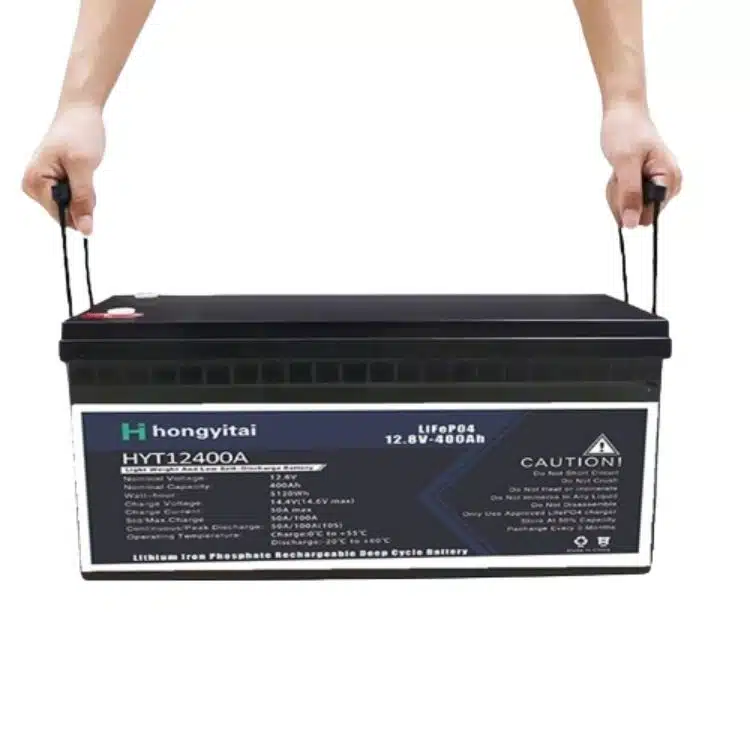
12.8V 400Ah LiFePo4 Battery
Nominal voltage: 12.8V
Nominal capacity: 400Ah
Rated energy: 5120Wh
Recommend charge current: ≤50A
Max charge current: 100A
Internal resistance: ≤12mΩ
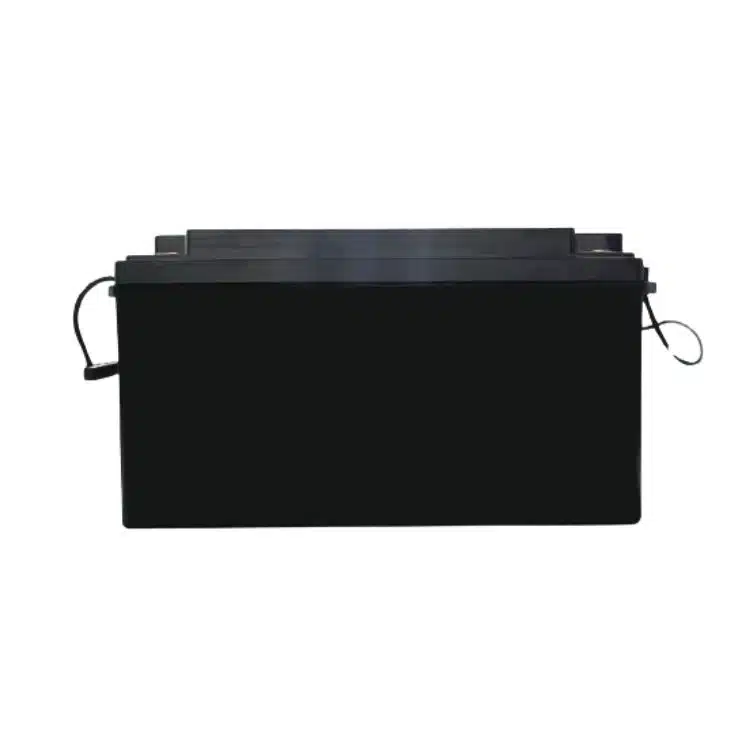
36V 50Ah LiFePo4 Battery
Nominal voltage: 38.4V
Nominal capacity: 50Ah
Rated energy: 1920Wh
Recommend charge current: ≤25A
Peak discharge current: 100A
Internal resistance: ≤30mΩ
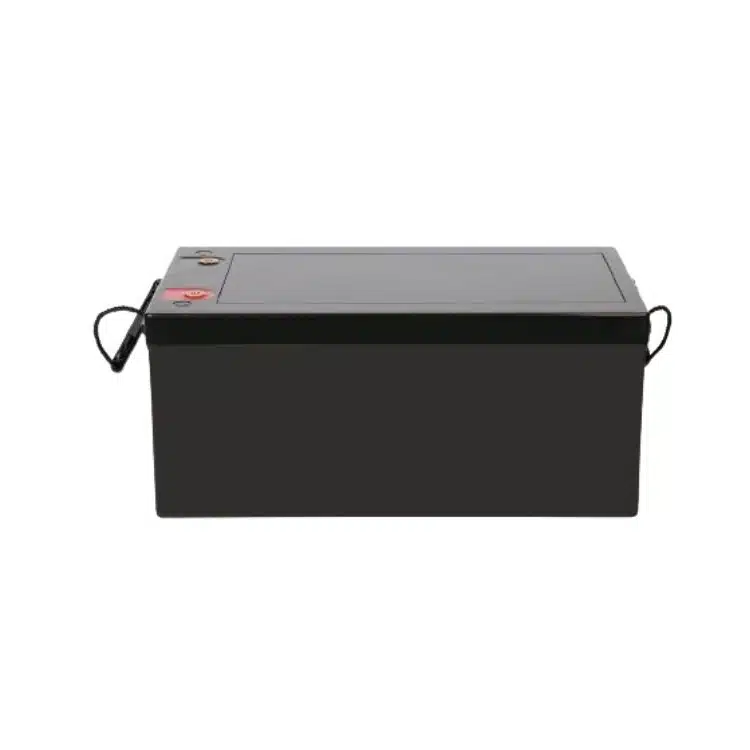
36V 100Ah LiFePo4 Battery
Nominal voltage: 38.4V
Nominal capacity: 100Ah
Rated energy: 3840Wh
Recommend charge current: ≤50A
Peak discharge current: 200A
Internal resistance: ≤25mΩ
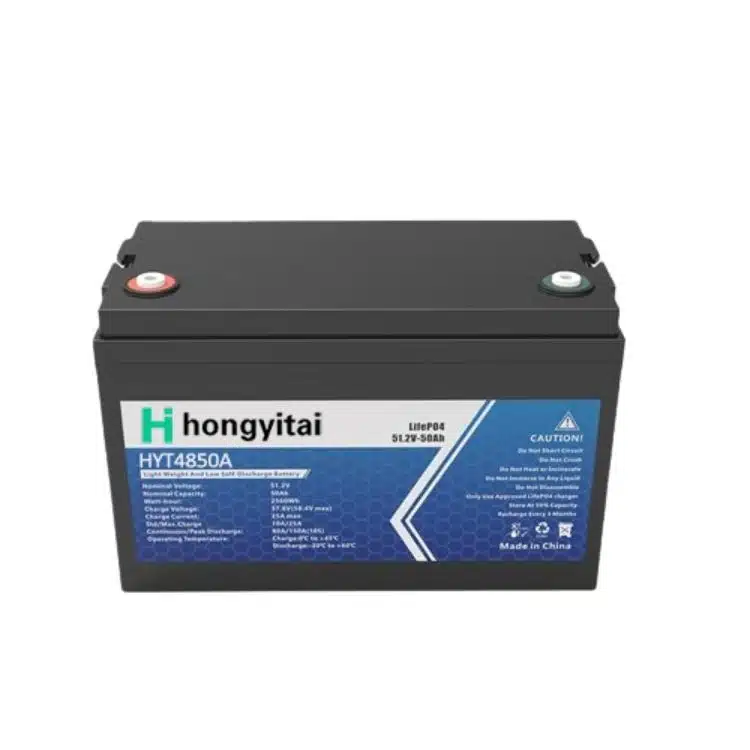
48V 50Ah LiFePo4 Battery
Nominal voltage: 51.2V
Nominal capacity: 50Ah
Rated energy: 2560Wh
Recommend charge current: ≤25A
Peak discharge current: 100A
Internal resistance: ≤30mΩ
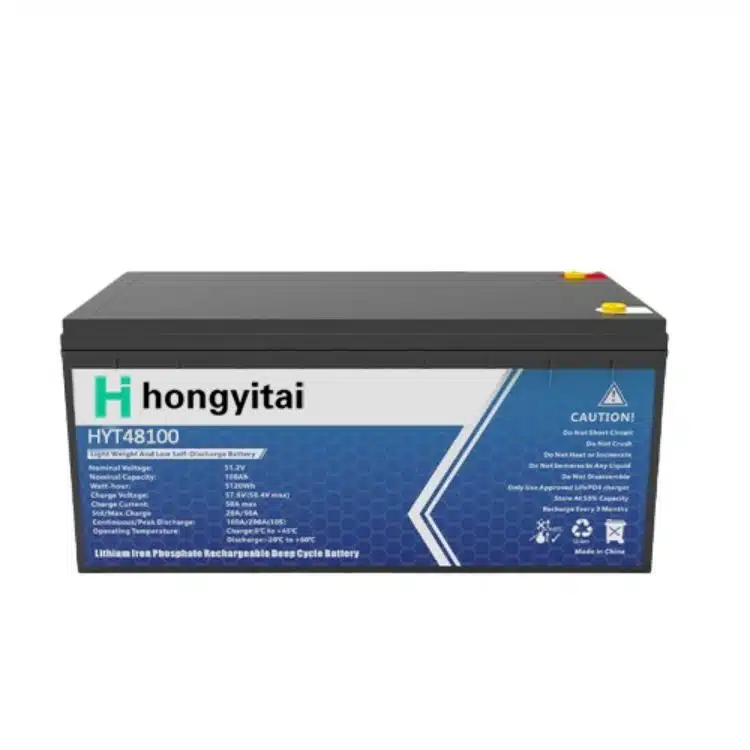
48V 100Ah LiFePo4 Battery
Nominal voltage: 51.2V
Nominal capacity: 100Ah
Rated energy: 5120Wh
Recommend charge current: ≤50A
Peak discharge current: 200A
Internal resistance: ≤20mΩ

Advantages of lithium batteries for golf carts
In the long run, lithium batteries for golf carts are more cost-effective. Although LiFePO4 batteries have a higher upfront cost and require a one-time investment, considering their 6000-cycle lifespan and maintenance-free nature, it’s recommended to use lithium batteries if the initial budget allows.
Lithium batteries are made from environmentally friendly materials and do not contain toxic lead metals like lead-acid batteries.
They are maintenance-free, unlike lead-acid batteries which require regular watering.
Differences between 12V, 36V, and 48V LiFePO4 Golf Cart Batteries
Below is an overview of the main differences and features of 12V, 36V, and 48V LiFePO4 batteries:
Voltage and Applications
- 12V Battery: Suitable for smaller golf carts
- 36V Battery: Mainly used for electric bicycles and some golf carts
- 48V Battery: Widely used in high-performance golf carts and base station projects
Power Output: The 48V system provides higher power output compared to the 36V system, suitable for applications requiring longer run times.
Efficiency: High voltage systems (such as 48V) are generally more efficient, especially in high-power applications.
Pros and Cons Comparison:
12V System
- Pros: Low cost, lightweight, ideal for low-power devices
36V System
- Pros: Moderate price, good power output, suitable for medium power needs
48V System
- Pros: High power output, high efficiency, suitable for large golf carts
Overall Recommendations:
Overall, the 12V system is suitable for small applications, the 36V system is suitable for medium power needs, and the 48V system is ideal for high-performance and large applications. Choosing the appropriate voltage system based on specific requirements can optimize performance, efficiency, and cost.

Nominal Voltage | Charging Voltage | Float Voltage | Max Voltage | Min Voltage |
|---|---|---|---|---|
12V | 14.6V | 13.8V | 15.6V | 8.0V |
36V | 43.8V | 41.4V | 46.8V | 24.0V |
48V | 58.4V | 55.2V | 62.4V | 32.0V |

Golf Cart Battery Replacement Guide
Golf cart lead-acid batteries are gradually being replaced by lithium batteries due to their longer cycle life and high-performance characteristics. Understanding how to properly replace the batteries is crucial.
Choosing the Right Replacement Battery
When replacing golf cart batteries, consider the following factors:
- Voltage: Confirm whether your golf cart requires 12V, 36V, or 48V voltage. Smaller golf carts typically use 12V systems, most modern golf carts use 48V systems, but some older models may use 36V systems.
- Size: Since you are replacing lead-acid batteries, measure the current battery compartment’s dimensions (length, width, height).
Replacement Steps
Preparation:
- Gather the necessary tools, including a wrench set, gloves, safety goggles, and battery straps.
- Turn off the golf cart and remove the key to ensure safety.
Removing the Old Battery:
- Disconnect the main negative cable first, then the main positive cable.
- Carefully remove the old battery from the battery compartment.
Cleaning the Battery Compartment:
- Clean the battery compartment with a baking soda solution to neutralize any acidic residue.
- Dry the battery compartment thoroughly.
Installing the New Battery:
- Place the new battery in the battery compartment in the same configuration as the old battery.
- Reconnect the cables, starting with the connections between the batteries, then the main positive and main negative cables.
Testing:
- Start the golf cart and test all functions to ensure the battery is working properly.
Apply Battery Terminal Protector Spray:
- Apply battery terminal protector spray to the battery terminals to prevent corrosion.
Maintenance Tips to Extend Battery Life
To extend the life of your golf cart battery, follow these recommendations:
- Timely Charging: Charge the golf cart battery after each use, even if you haven’t used all the power. Keep the battery at about 50% charge.
- Avoid Extreme Temperatures: Store the golf cart in a cool, dry place whenever possible.
- Regular Visual Inspections and Voltage Testing: Regularly check the battery for signs of corrosion or damage and use a voltmeter to test the battery voltage.
By following these steps and properly maintaining your new battery, you can ensure optimal performance and a longer lifespan for your golf cart.
Golf cart battery charger
A golf cart battery charger is a device specifically designed to charge golf cart batteries. They are typically different from standard battery chargers due to the following features:
Voltage Selection: Golf cart battery chargers come in three common voltages: 12V, 36V, and 48V. It is crucial to choose a charger that matches your golf cart battery system voltage. For a 12V battery, select a 12.8V charger; for a 36V battery, choose a 43.8V charger; and for a 48V battery, use a 54.75V charger.
Charging Current: The output current of golf cart battery chargers is typically between 15 to 20 amps. The charging current should be one-third to one-half of the total battery capacity. Higher charging currents can shorten charging times, but too high a charging current can affect the battery’s cycle life.
Compatibility: Most golf cart battery chargers are compatible with lead-acid batteries, AGM batteries, and gel batteries. Some advanced chargers can also be programmed to adapt to lithium-ion batteries.
Smart Features: Many golf cart battery chargers have smart features such as automatic shut-off and trickle charging to prevent overcharging. Additionally, some advanced chargers have multi-stage charging (constant current, constant voltage, and trickle charging) to optimize the charging process and extend battery life.
Safety Features: Golf cart battery chargers usually come with safety features like overcurrent, overvoltage, and over-temperature protection to prevent battery damage and potential safety hazards.
Portability: Golf cart battery chargers come in two main types: portable and onboard. Portable chargers are generally smaller and lighter, making them easy to carry and store. Onboard chargers (OBC) are installed within the golf cart, providing a more convenient charging method.
Price Range: The price range of golf cart battery chargers varies widely, from basic chargers costing $70 to over $250 for high-end smart chargers. When choosing a charger, consider your budget and needs.
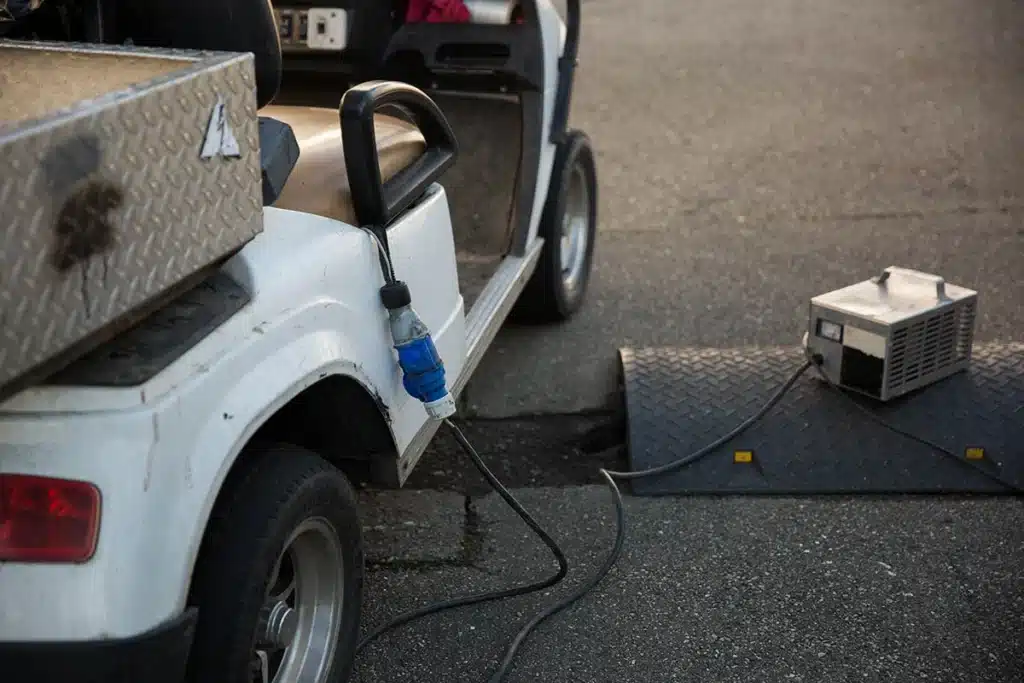
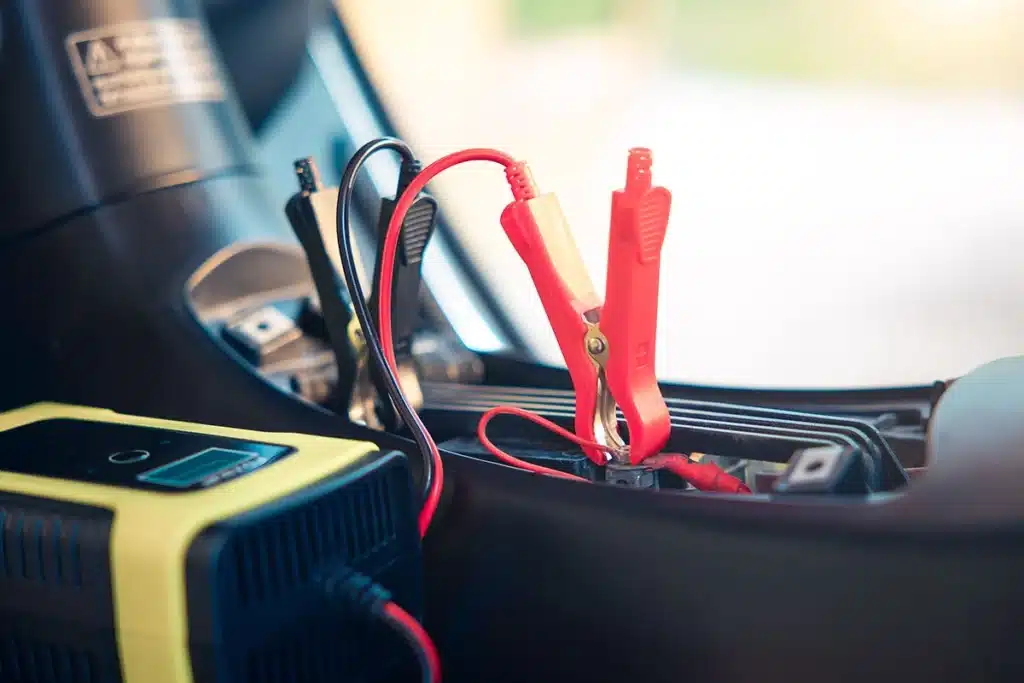
How to Choose a Golf Cart Battery Charger
When selecting a golf cart battery charger, consider the following factors:
- Your Golf Cart Battery Voltage: Ensure you choose a charger that matches your battery system voltage.
- Your Charging Needs: If you need fast charging, choose a charger with a higher charging current. However, remember that higher charging currents can shorten battery life.
- Your Battery Type: Ensure the charger is compatible with your battery type.
- Features You Need: Decide if you need smart features such as automatic shut-off, trickle charging, and multi-stage charging.
- Your Budget: Choose a charger that fits your budget.
Golf Cart Battery Charger Recommendations
Here are some recommended golf cart battery chargers: Zapp FX Series 36V/48V 15A Smart Battery Charger, CTEK MXS 36V/48V 10A Smart Battery Charger, and NOCO Genius G35 36V/48V 35A Smart Battery Charger. These three models have received positive feedback from customers. Of course, feel free to consult us about other charger models.
FAQs for batteries for golf cart
The price range for golf cart batteries varies widely, primarily depending on the following factors:
Battery Type: Lead-acid batteries are currently the most common type of golf cart battery and are relatively inexpensive. AGM batteries and lithium-ion batteries are newer technologies, generally more expensive than lead-acid batteries but offer longer lifespans and higher performance.
Battery Capacity: Battery capacity refers to the battery's ability to store energy, usually measured in ampere-hours (Ah). The higher the battery capacity, the higher the price.
Brand: Prices can vary significantly between different brands, with well-known brands typically costing more.
Here are some price references for golf cart batteries:
- Traditional Lead-Acid Batteries: A single 6V 225Ah Trojan T-105 battery costs about $150. These batteries have large capacities and are commonly used in 48V golf cart systems.
- AGM Batteries: A 48V 190Ah US Battery GC2 AGM battery pack costs about $2,820. AGM batteries offer longer lifespans and higher performance than lead-acid batteries.
- Lithium-Ion Batteries: Lithium-ion batteries are generally more expensive than lead-acid batteries but offer longer lifespans and better performance. The price of a single small-capacity lithium battery varies widely depending on battery voltage and capacity. Please contact us for detailed information.
Please note that the above prices are for reference only. Actual prices may vary due to market fluctuations. Some 48V lithium batteries are made of four 12V lithium batteries in series, while others are a single 48V battery pack.
In summary, if you are looking for affordable and easy-to-maintain batteries, lead-acid batteries are a good choice. If you need longer lifespan, higher performance, and less maintenance, lithium-ion batteries are a better option.
Golf cart batteries gradually age and lose performance over time, so regular testing is essential to ensure they are working correctly and to identify potential issues early. Here are some methods for testing golf cart batteries:
Visual Inspection:
- Check for any physical damage such as cracks, breaks, or deformation of the battery casing.
- Inspect the battery terminals for any signs of corrosion or buildup.
- Ensure all battery connections are secure and there are no loose or damaged wires.
Voltage Testing:
- Use a digital multimeter set to DC voltage.
- For 6V batteries (mainly lead-acid), test each battery individually. Connect the multimeter probes to the battery's positive and negative terminals. A fully charged 6V battery should read 6.3-6.6V.
- For 12V, 36V, or 48V battery systems, test the entire battery pack. Connect the multimeter probes to the total positive and total negative terminals of the battery pack. A 12V pack should read 13.2-13.8V, a 36V pack should read 37.5-39V, and a 48V pack should read 50.8-53.2V.
Specific Gravity Testing (only for flooded lead-acid batteries):
- Use a hydrometer to test each cell of the battery.
- The specific gravity of a fully charged lead-acid battery cell should be 1.265-1.280.
- If the specific gravity difference between cells exceeds 0.050, the battery may have an issue.
Load Testing:
- Use a battery load tester.
- Connect the load tester to the battery.
- Apply a load equivalent to half the battery's cold cranking amps (CCA) rating for 15 seconds.
- For a 6V battery, the voltage should not drop below 4.7V during the load test.
Discharge Testing:
- Use a battery discharge tester.
- Connect the discharge tester to the battery pack.
- Apply a 75-amp load to the entire battery pack.
- A healthy 36V battery pack should last about 105 minutes before reaching 75% discharge.
Precautions:
- Always read and follow the manufacturer's instructions before testing the batteries.
- Wear protective gear such as safety goggles and gloves.
- Do not connect the golf cart to a charger or any other power source during testing.
- If one battery in the pack fails, it is generally recommended to replace the entire battery pack.
- Regular maintenance and proper charging can extend battery life.
By following these steps and guidelines, you can ensure your golf cart batteries remain in good condition and perform optimally.
The number of batteries required for a golf cart depends on its voltage system and battery type. Here are some common golf cart battery configurations:
36-Volt System: Typically requires 1 x 36-volt battery or 3 x 12-volt batteries.
48-Volt System (most common): Typically requires 4 x 12-volt batteries or 1 x 48-volt battery.
Note:
- The number and type of batteries will affect the performance, range, and maintenance requirements of the golf cart.
- A 48-volt system usually provides more power and higher efficiency than a 36-volt system.
- Although lithium-ion batteries have a higher initial cost, they have a longer lifespan and require less maintenance.
When choosing batteries, consider the following factors:
- Usage Frequency: If you use the golf cart frequently, a more powerful battery pack is needed to provide longer range.
- Budget: Lithium-ion batteries have a higher initial cost than lead-acid batteries, but a single battery pack is better for daily operations.
- Maintenance Preference: Lead-acid batteries require regular checks and maintenance, whereas lithium-ion batteries require less maintenance.
Overall, most modern golf carts use a 48-volt system, typically requiring 1 x 48V battery, depending on the battery type and voltage chosen. When replacing or upgrading batteries, be sure to select batteries that are compatible with your golf cart model and voltage system.
Here is an overview of the lifespan of a 48-volt golf cart battery:
Average Lifespan:
- Generally, the lifespan of a 48-volt golf cart battery ranges from 6 to 10 years.
- Generally, the lifespan of a 48-volt golf cart battery ranges from 6 to 10 years.
Impact of Battery Type:
- Lead-Acid Batteries: Typically have a shorter lifespan, around 4-6 years.
- Lithium-Ion Batteries: Have a longer lifespan, ranging from 8-10 years, with some lasting even longer.
- Lead-Acid Batteries: Typically have a shorter lifespan, around 4-6 years.
Factors Affecting Lifespan:
- Usage Frequency: Frequent use can shorten the battery lifespan.
- Maintenance Quality: Regular and proper maintenance can extend the lifespan.
- Charging Habits: Keeping the battery around 50% charge helps prolong its lifespan.
- Environmental Factors: Extreme temperatures can affect battery performance and lifespan.
- Usage Frequency: Frequent use can shorten the battery lifespan.
Tips for Extending Battery Lifespan:
- Charge the battery after each use.
- Avoid deep discharges of the battery.
- Use an appropriate charger.
- Regularly check and maintain the battery (especially for lead-acid batteries).
- Keep the battery partially charged when not in use.
- Charge the battery after each use.
When to Replace:
- When the battery can no longer hold sufficient charge.
- When charging time significantly increases.
- When golf cart performance noticeably declines.
- When the battery can no longer hold sufficient charge.
Overall, the lifespan of a 48-volt golf cart battery largely depends on the battery type, usage, and maintenance. With proper care and usage, you can maximize the battery's lifespan, enhancing the overall performance and value of your golf cart.
Here is a step-by-step guide for connecting golf cart batteries:
Safety Preparation:
- Wear protective gloves and safety goggles.
Determine Battery Voltage:
- Identify whether your golf cart uses a 12V, 36V, or 48V system.
Clean and Inspect:
- Clean the battery terminals and connecting wires.
Connect the Batteries:
- Start by connecting the negative (-) terminals.
Connect the Main Power Line:
- Connect the main positive (+) line to the positive terminal of the battery pack.
Check Connections:
- Carefully check that all connections are correct and secure.
Test:
- Turn on the golf cart and check if it is working properly.
Final Steps:
- Apply anti-corrosion spray to the battery terminals.
Notes:
- If you are unsure how to proceed, please contact us.
- Strictly follow the battery positive and negative connection order.
- Avoid accidental contact of tools with multiple battery terminals to prevent short circuits.
By carefully following these steps, you can safely and effectively connect golf cart batteries. Proper connections are crucial to ensuring the performance and lifespan of your golf cart batteries.
Here are important tips for charging golf cart batteries:
Charge After Each Use:
- Even if used for a short time, try to charge up to 50%.
- Even if used for a short time, try to charge up to 50%.
Use the Appropriate Charger:
- Choose a charger specifically designed for your battery type and voltage.
- Ensure the charger has safety features to prevent overcharging.
- Choose a charger specifically designed for your battery type and voltage.
Avoid Overcharging:
- Do not continue charging for a long time after the battery is fully charged; use a charger with an automatic shut-off feature if possible.
- Do not continue charging for a long time after the battery is fully charged; use a charger with an automatic shut-off feature if possible.
Maintain Proper Water Levels (for Lead-Acid Batteries):
- Check water levels monthly and add distilled water if necessary.
- Only add water after the battery is fully charged.
- Check water levels monthly and add distilled water if necessary.
Regular Maintenance:
- Keep the battery clean to prevent corrosion.
- Regularly check and tighten connections.
- Keep the battery clean to prevent corrosion.
Avoid Deep Discharge:
- Try not to discharge the battery below 20% of its capacity, also known as reserve capacity.
- Try not to discharge the battery below 20% of its capacity, also known as reserve capacity.
Temperature Considerations:
- Lithium batteries charge best between 0°C and 45°C (32°F and 113°F).
- Lithium batteries charge best between 0°C and 45°C (32°F and 113°F).
Following these tips can help extend the lifespan of your golf cart batteries and ensure optimal performance.
